Carriacou
Carriacou is an island of the Grenadine Islands. It is a dependency of Grenada, and is located in the south-eastern Caribbean Sea, northeast of the island Grenada and the north coast of South America. The name is derived from the Carib language Kayryouacou.
| Native name: Kayryouacou Nickname: Land of Reefs | |
|---|---|
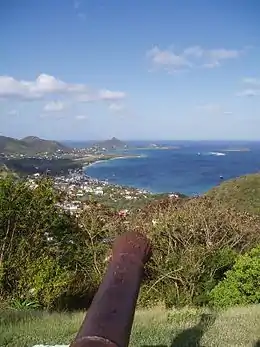 A view of Hillsborough, the capital of Carriacou | |
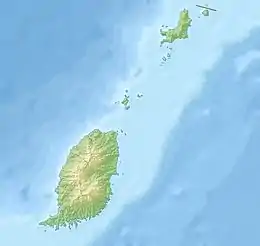 Carriacou 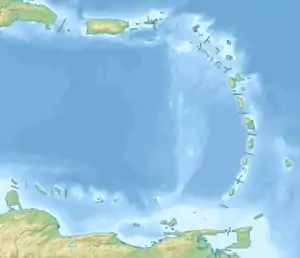 Carriacou 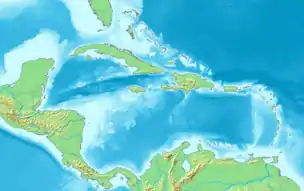 Carriacou | |
| Geography | |
| Location | Caribbean |
| Coordinates | 12°28′00″N 61°27′00″W |
| Archipelago | Grenadines |
| Area | 12 sq mi (31 km2) |
| Length | 7 mi (11 km) |
| Width | 2 mi (3 km) |
| Highest elevation | 956 ft (291.4 m) |
| Highest point | High North Peak |
| Administration | |
| Largest settlement | Hillsborough (pop. 1,200) |
| Prime Minister of Grenada | Dr. Keith Mitchell |
| Demographics | |
| Population | 10,000 |
| Pop. density | 176.47/sq mi (68.135/km2) |
| Ethnic groups | African, European, Native people. |
Government
Carriacou is a dependency of Grenada and part of the Carriacou and Petite Martinique Constituency.
Geography
Carriacou is the largest island in the Grenada Grenadines. It is also the largest island in the Grenadine Islands (Vincentian and Grenadian Grenadines). It is located at latitude 12° 28' N, longitude 61° 27' W.
Facts
Carriacou is home to 8,000 people. The capital city is Hillsborough, the only town or city on the island. The port authority is in Tyrell Bay which is also where the ferry from Grenada docks. Tyrell Bay has various bars and restaurants and is where the mangroves are situated which is a protected area, oyster bed and is used by yachts to shelter from hurricanes. Most of the other island settlements are very small villages. There are more than 100 rum shops in Carriacou. Carriacou is home to Herbert Augustus Blaize, the founder of GNP (Grenada National Party) and the former Chief Minister of Grenada. Carriacou is a popular vacation destination for both Grenadians and foreign visitors, many of whom arrive by yacht. Noteworthy beaches in Carriacou include Paradise Beach and Anse La Roche. European (English or French) dances, such as the Quadrille, are still popular on the island today. The Big Drum dance is the most popular dance on the island and is performed on a special occasions. Carriacou is reputed to be the friendliest, healthiest and safest island in the Caribbean. Carriacou's Pierrot, or Shakespeare Mas, is originally from Mt.Royal.
Diving
Carriacou is known as the "Isle of Reefs", and features some of the most unspoiled coral reefs in the region. Most diving takes place on the calmer Caribbean side of the island, where 33 dive sites suitable for all levels of divers can be found. Depths range from 12 m (39 ft) down to a maximum of 30 m (98 ft). Visibility is good throughout the year, with excellent opportunities for underwater photography.
All of Carriacou's dive sites boast a spectacular array of vibrant corals and schooling fish that have made the Caribbean a famous diving hotspot. Dive sites range from the tranquil and sheltered for beginners and underwater photography enthusiasts to fast drifts for those that love a challenge. Carriacou also features two wreck dives: the Westsider and Boris tug boats, both 30 m (98 ft) long, which were sunk as artificial wrecks for divers in 2004 and 2007 respectively.
Underwater fauna
As well as all the usual Caribbean reef fish, large nurse sharks, barracudas, Southern & roughtail stingrays, as well as spotted eagle rays, hawksbill and green turtles are frequently sighted. During the summer months spectacular schools of silversides may be seen. During late spring, humpback whales migrate past the island, and their song can be heard by scuba divers from a long way off.
Climate
| Celsius °C | Fahrenheit °F | |
|---|---|---|
| Land | 27-32 | 80-85 |
| Sea | 26-30 | 78-82 |
Dry season is from January to June and the rainy season is from July to December.
Hurricanes
The first record of a hurricane on the island was on August 14, 1944. In 1955 the second floor of the Beausejour great house was blown away by Hurricane Janet. Recent hurricanes: Hurricane Ivan on September 7, 2004 and Hurricane Emily on July 13, 2005.
History
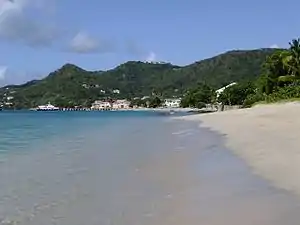


Between 500 and 1000 AD\CE, Amerindians came to Carriacou. These Carib settlers called Carriacou Kayryouacou, meaning "the land of reefs."
In 1656, Jean-Baptiste Du Tertre, a turtle fisherman living in Guadeloupe, visited Carriacou. He was the first recorded French/European person to visit the island. It was colonized first by the French among the European newcomers.
In 1720, Bartholomew Roberts captured a French ship near Carriacou and commandeered it, renaming it the Royal Fortune.
In 1750, the first census of the island was conducted. It recorded 199 people (92 Whites, 92 Blacks and 15 Mixed Race, people of African descent were mostly enslaved) living in Carriacou.
In 1763 near the end of the Seven Years' War, Carriacou was ceded with Grenada by the French to the British after their defeat in the war. In addition, the British had captured neighbouring Grenada. In 1776, the island population was 3,239 (86 Whites and 3,153 slaves), not counting the free Blacks and the free Mulattos or people of colour. In 1791, Gun Point (Rapid Point), which had been a division of the Grenadines, was made a latitude on the island. The Point belonged to Saint Vincent and the rest of Carriacou belonged to Grenada.
In 1870, Stephen Joseph Perry led a British government expedition to observe a solar eclipse at Carriacou. In the 19th century, the Pierrot Mas was first introduced to Carriacou. In 1922, Petite Charles first introduced the Jab Jab (Devil) Mas to Carriacou. The telephone system began operating in 1961 on Carriacou. Bishop's College was the first secondary school in Carriacou; it was opened in 1964 by the Anglican Church. In 1965, the Carriacou Regatta began. In 1965?1968 Lauriston airport/airstrip was opened. On October 31, 1975, the Carriacou Carib Organization (CCO) began.
The inhabitants of Carriacou perform the "Big Drum" or "Nation," dance which celebrates their West African ancestors who were brought to the island during slavery. These Big Drum dances are usually performed at "Maroons" village festivals or fetes, where food and drink are prepared. They can also be danced at wakes and tombstone feasts in honour of dead relatives. The Quadrille dance is also performed on the island during festivals and historic events.
A traditional boat-building culture located in the village of Windward, on the north-eastern side of the island. Carriacou's people of Scottish and Irish ancestry are concentrated here. [1]
Carriacouans have migrated to the United Kingdom, and especially to the county town of Huddersfield. It is said that if you live in Carriacou you will have a family member in Huddersfield, and if you live in Huddersfield you will surely know someone from Carriacou. Other English locations where Kayaks (nickname for people from Carriacou) congregate is London. The rector of St Stephens is the Archbishop of Canterbury's Visitor to the Windward Island diocese. The United States, particularly New York City, is home to a significant number of Carriacouans. Many Carriacouans do return for holidays or to retire "back home".
Limes and citrus products were the leading exports during the 18th century.
Colonial history
On 27 September 1650, Jacques du Parquet bought Grenada from the Compagnie des Iles de l'Amerique, which was dissolved, for the equivalent of £1160. In 1657, Jacques du Parquet sold Grenada to the Comte de Cerrillac for the equivalent of £1890. In 1664, King Louis XIV bought out the independent island owners and established the French West India Company.[2] In 1674 the French West India Company was dissolved. Proprietary rule ended in Grenada, which became a French colony.[2]
Carriacou was part of the French colony in 1762. Following French defeat in the Seven Years' War, it ceded its territories to Britain. The island was part of the British Grenada colony from 1763-1779 and 1783-1974. It was part of French Grenada colony from 1779-1783. It has been a dependency of Grenada since 1974.
On November 1, 1983 during Operation Urgent Fury, two companies from the 22nd Marine Amphibious Unit made a combined sea and helicopter landing on Carriacou. The nineteen Grenadian soldiers defending the island surrendered without a fight. This was the last military action of the campaign.[3]
Native name
In the 17th and 18th centuries, Carriacou was spelled 'Kayryouacou' in Carib.
Notable residents
- Herbert Augustus Blaize - former Chief Minister of Grenada
- Canute Caliste - native painter
- Leonard James Paterson - father of Basil Paterson, grandfather of David Paterson
- Linda Lorde - mother of writer Audre Lorde
- Malvina Wells (1804-1887), born in Carriacou, only known person buried in Edinburgh who was born a slave
In literature
- Carriacou and the Big Drum are featured in Paule Marshall's novel Praisesong for the Widow.
- The memory of Carriacou (from which her parents emigrated to New York) figures prominently in Audre Lorde's autobiographical work Zami: A New Spelling of My Name.
Panorama

References
- "Vanishing Sail" -- documentary on boatbuilding in Windward (external link)
- Steele, page 54
- Kreisher, Otto (October 2003). "Operation URGENT FURY - Grenada". Marine Corps Association and Foundation. Archived from the original on 19 April 2016. Retrieved 28 April 2016.
External links
| Wikivoyage has a travel guide for Carriacou. |